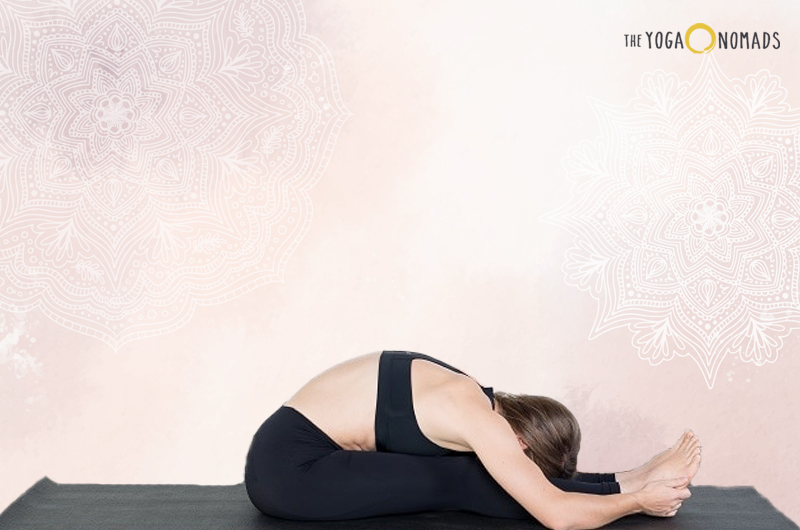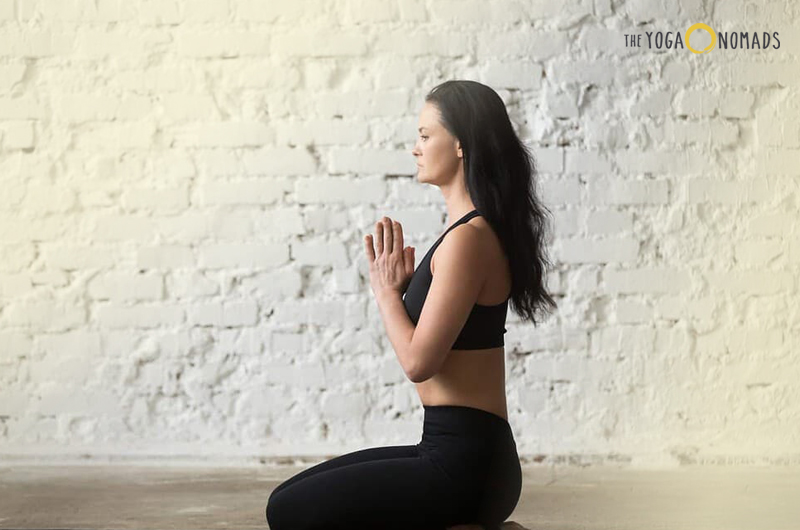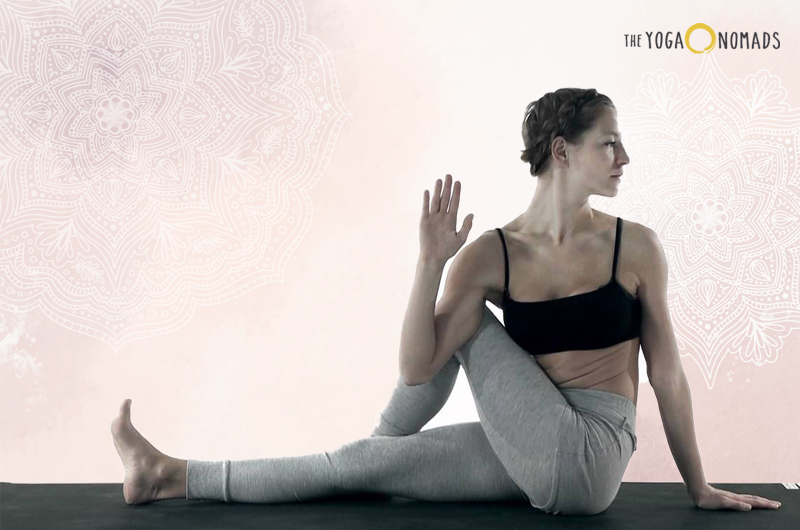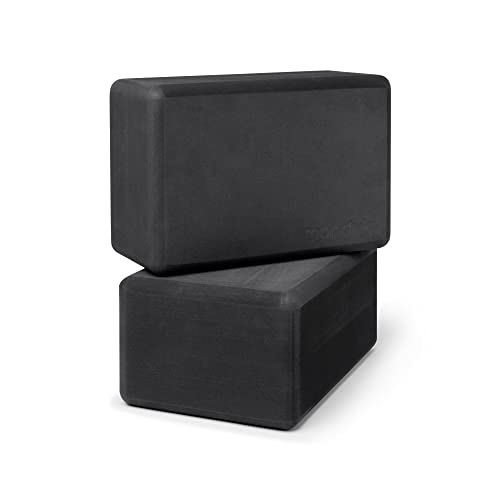Listen to this article:
Quick Tip: Yoga can alleviate acid reflux symptoms through gentle poses that improve digestion and reduce stress.
The uncomfortable, burning sensation associated with acid reflux isn’t a pleasant experience, but yoga can help. With a few mellow yoga poses, the symptoms of acid reflux may ebb into oblivion, giving you the relief you’re seeking.
In this article, we unlock the potential of yoga for acid reflux management. We have reviewed five of the best yoga poses to alleviate acid reflux and how they help. To start, let’s take a look at acid reflux and what it is.
What Is Acid Reflux?

Girls regret eating food near the subway. Portrait of displeased worried woman feeling discomfort in stomach holding hands on belly smirking and frowning looking left having stomachache or disorder.
Acidity, also known as acid reflux, is a common condition that occurs due to excess acid production in the stomach. At the base of your stomach, there’s a ring of muscle called the lower esophageal sphincter (LES), which acts as a valve.
When everything runs smoothly, the LES closes behind food, blocking the stomach’s acids from entering the esophagus. However, if the LES doesn’t close all the way or opens too frequently, it can allow stomach acid to move into the esophagus.
This produces a burning sensation in the chest, commonly known as heartburn. Doctors recognize these symptoms as acid reflux disease or gastroesophageal reflux disease (GERD) when people experience them more than twice a week. Conversely, some people only experience occasional acid reflux.
What Causes Acid Reflux?
Millions of Americans experience acid reflux symptoms every year, with approximately 20 percent experiencing acid reflux occasionally or regularly. These symptoms can result from various risk factors, including the following:
- Snacking close to bedtime
- Being overweight or obese
- Consuming a large meal
- Lying down immediately after eating
- Lying on your back or bending at the waist after consuming a large meal
- Consuming specific foods, including citrus, chocolate, mint, tomato, onions, garlic, spicy foods, or fatty foods
- Drinking specific beverages, including coffee, tea, alcohol, or carbonated drinks
- Smoking
- Being pregnant
- Taking various medications, including aspirin, ibuprofen, some muscle relaxers, or blood pressure medications
Yoga for Acid Reflux
Yoga can be used as a natural way to help relieve symptoms of GERD, a condition called gastroesophageal reflux disease. Yoga poses for acid reflux focus on the digestive system and can help reduce acid reflux by improving digestion and reducing stress.
Certain yoga exercises like agnisar kriya can specifically target the symptoms of gerd and hiatal hernia. A certified yoga teacher or online resources those are well reputed and certified can guide you through yoga poses to help with acid reflux.
Gentle poses and forms of pranayama can help ease the symptoms by bringing blood flow to the abdomen, which helps with digestion.
A study on GERD found that 45.6 percent of individuals reported stress as a factor impacting their reflux symptoms. Another study connected the dots between increased stress levels and an influx in the secretion of stomach acids.
More acid in the stomach can translate to aggravated symptoms, so researchers began exploring yoga as a potential solution to calm stress levels and alleviate symptoms.
Through further studies, researchers discovered that yoga might help lower the body’s stress response, making it a potentially effective treatment for GERD.
5 Of The Best Yoga Poses To Relieve Acid Reflux
Acid reflux is an unpleasant experience, so if you’re contending with its effects, yoga might help. Try the following 5 yoga poses to relieve and control acid reflux:
Seated Forward Bend pose (Paschimottanasana)

Commonly known as the seated forward bend pose, this pose is ideal for stretching the muscles and aiding digestion, offering acid reflux relief. To start, sit on your yoga mat with your legs and hands at your sides.
Tighten the core to bring blood flow to the area, focusing on your breathing. When you’re ready, fold forward, stretching your hands toward your toes. If you’re comfortable, advance the pose by bringing your forehead and chest toward your legs.
Avoid forcing your head or chest to touch your legs; remember to work within your limits. Hold the pose for three minutes or as long as you’re comfortable, breathing deeply through the pose.
Reclining bound angle pose (Supta Baddhakonasana)
This pose, also known as the reclining bound angle pose or reclining butterfly pose, is a soothing balm for an agitated stomach producing acid reflux symptoms. It gently reduces the symptoms by allowing gravity to work its magic in lowering acid out of the esophagus.
You’ll need a few props for this pose, including a pillow, a couple of blankets, or a pair of yoga blocks.
Start in a seated position, then slowly recline on your exhale, leaning back to rest on your forearms. Position a prop behind your head to elevate it above your chest, ensuring your neck is comfortable.
Bring your feet together, placing the soles together to create a diamond shape with your legs. Place your left hand on your stomach and the right on your heart, breathing through the pose for five to ten minutes.
Thunderbolt pose (Vajrasana )

The thunderbolt pose, or Vajrasana, fixes hyperacidity, causing acid reflux, while simultaneously enhancing blood circulation to the abdomen. To start, kneel on the ground, resting your bottom on your heels.
Keep your spine straight and your head and neck in a neutral position, with your hands resting gently atop your knees. Hold the position for around 10 minutes, focusing on deep, even breathing.
Cobra pose (Bhujangasana)

In the cobra pose or bhujangasana, you allow gravity to do its work in keeping acid reflux at bay. While the pose is an active one that offers a deep, glorious stretch through the chest, shoulders, and neck, it also gently massages and stretches the digestive organs.
To start, lie in a prone position on the floor with the tops of your feet resting on the mat. Place your hands beneath your shoulders, keeping your elbows tucked toward your ribs. When you’re ready, press into the floor with your feet, thighs, and hips, pushing through your palms to raise your upper body off the floor.
Raise as high as you can before your lower body begins to rise from the floor. Lift your chest, keeping your ribs from flaring outward. Breathe as you hold, remaining in the pose for 30 seconds to one minute. When you’re ready, exhale and bend your elbows to lower your body back to the floor.
Half-spinal twist pose (Ardha Matsyendrasana)

The half-spinal twist pose, or Ardha Matsyendrasana, helps stretch the abdominal muscles, bringing blood flow to the area and helping with digestion. Start seated with your right leg over the left, so the left foot lies along the right pelvic region.
Bend your right knee to bring your right foot over the left knee, and twist the upper body to the right, bringing the left arm toward the right knee. Hold the pose for a few breaths, then repeat on the other side by bringing the right foot over the left knee.
Strengthening Your Diaphragm
Importance of Diaphragm Strength
It’s crucial to focus on strengthening the diaphragm for individuals dealing with reflux. This muscle, located below the lungs, plays a role in our breathing.
Goes beyond that by helping to maintain stomach acids in their rightful place. A robust diaphragm acts like a lid on a jar, ensuring that everything remains contained without any spillage.
Benefits of Yoga
Yoga proves to be incredibly beneficial for enhancing diaphragm strength. Engaging in yoga poses requires us to regulate our breathing, which effectively works out the diaphragm and enhances its strength gradually.
Just as lifting weights can build arm muscles, controlled breathing exercises, during yoga can strengthen your diaphragm. This improvement can significantly alleviate acid reflux symptoms by keeping stomach acids in check.
So the next time you unroll your yoga mat, remember that you’re not just benefiting your mind and muscles but also nurturing your health.
Ayurvedic Role in Addressing Acid Reflux with Yoga
Ayurveda, a healing system from India, sees reflux as a manifestation of imbalance in the body’s fire element, known as Pitta. This viewpoint is captivating, as it presents a method for addressing reflux symptoms.
Ayurvedic teachings propose that specific yoga postures can help restore balance to the pitta within the body. It goes beyond movements and encompasses dietary adjustments and lifestyle modifications.
For example, steering clear of spicy and acidic foods can complement your yoga routine in managing acid reflux. It’s an approach that considers the body in its entirety.
From my experience, intertwining yoga with principles has made a significant difference for me. It’s not about practicing yoga poses but grasping how various facets of life impact acid reflux.
Ayurveda advocates for a cooling diet and activities that alleviate stress while fostering equilibrium. This method has proven beneficial for me. I believe it presents a perspective on managing acid reflux through yoga.
I haven’t come across articles exploring this approach. It blends physical exercises with dietary choices and lifestyle adjustments.
This viewpoint might provide individuals with an approach to handling their symptoms. It extends beyond practicing yoga; it involves embracing a lifestyle shift inspired by aging insights.
Other Options for Managing Acid Reflux
Over the Counter (OTC) Antacids
While practicing yoga can be a helpful natural solution for acid reflux, there are times when you may require additional support. OTC antacids work swiftly to neutralize stomach acid, offering quick relief from heartburn and indigestion. These products are readily available at most drugstores.
Medications Prescribed by a Doctor
If OTC remedies aren’t effective enough, your healthcare provider may suggest stronger medications. These could include H2 blockers or proton pump inhibitors (PPIs) that are more efficient in reducing acid production. It’s important to always seek advice from your doctor before starting any new medication.
Surgical Intervention
In severe instances, surgery might become an option. Procedures such as fundoplication can help reinforce the lower esophageal sphincter to prevent the backflow of acid into the esophagus. Surgery is typically considered as a final solution when other treatments have not yielded desired results.
Adapting Lifestyle Habits
Apart from incorporating yoga into your routine, making lifestyle adjustments can have a significant impact on managing acid reflux. Practices such as avoiding trigger foods, consuming smaller meals and refraining from lying down immediately after eating can be beneficial. Maintaining a healthy weight and quitting smoking also play crucial roles in managing this condition.
When to Seek Medical Advice
If you find yourself experiencing acid reflux more than twice weekly, it’s advisable to consult with a healthcare professional promptly. Persistent symptoms could potentially lead to complications like esophagitis or Barrett’s esophagus.
Intervening early can help avoid these problems.
When you incorporate yoga into these therapies, you can better control acid reflux. It’s always a good idea to consult with your healthcare provider to customize a plan that suits you best.
The Significance of Yoga Nidra in Dealing with Acid Reflux
Yoga Nidra can be a beneficial yoga practice for those suffering from acid reflux. While it may not directly treat acid reflux, it can be used to treat the symptoms associated with it. Practicing yoga helps to reduce acidity in the stomach, which can contribute to acid reflux. One of the main lifestyle factors that can lead to acid reflux is stress. Yoga, particularly when combined with techniques like yoga nidra, can help to relieve stress and promote relaxation.
Understanding Yoga Nidra
Yoga Nidra, also known as “yogic sleep,” refers to a state of conscious relaxation. Unlike the typical yoga postures, Yoga Nidra concentrates on profound mental and emotional relaxation. It entails guided meditation that leads you through various levels of awareness.
Benefits of Yoga Nidra for Acid Reflux
Acid reflux is often triggered by stress. Utilizing Yoga Nidra can serve as an effective method to combat stress. By fostering deep relaxation, it aids in reducing the production of stomach acids, thereby easing acid reflux symptoms.
Personal Experience with Yoga Nidra
In my own encounters with Yoga Nidra, I have discovered it to be highly beneficial in managing stress induced acid reflux. Following a session, I experience a deep sense of tranquility. This peaceful state results in fewer occurrences of acid reflux. The guided meditation assists me in concentrating on my breath and body, lessening tension.
Practicing Yoga Nidra
Engaging in Yoga Nidra does not necessitate any specialized equipment. Locate a serene and cozy area. Lie down on your back with your arms resting at your sides. Close your eyes and follow along with a guided meditation session. Numerous applications and online platforms offer complimentary sessions for practicing Yoga Nidra.
Integrating Yoga Nidra into your daily routine could make a significant difference in managing acid reflux.
It focuses on tackling the underlying issue, which is stress, instead of just treating the symptoms. Why not give it a shot and observe how it changes your approach to managing acid reflux?
Pop quiz! 🧘🤔
Yoga can worsen acid reflux if incorrect poses are performed.
The Cobra pose is beneficial for acid reflux relief.
Acid reflux is only caused by the types of food you eat.
Frequently Asked Questions (FAQs)
What Yoga Is Best for Acid Reflux?
When experiencing symptoms of acid reflux, it’s best to stick with gentle, upright yoga positions. Inverse positions can worsen symptoms, so opt for upright poses that offer soothing stretches and increased blood circulation to the stomach and abdomen, as this will help pacify the symptoms.
Is it OK to do Yoga with Acid Reflux?
You can do yoga with acid reflux! Calm, soothing yoga postures can alleviate symptoms of acid reflux by improving blood circulation to the abdomen and reducing stress. Stick to upright poses that allow gravity to work in tandem with your efforts.
Can Yoga Make Acid Reflux Worse?
Some poses in yoga, like the downward-facing dog or swan dive, can aggravate the symptoms of acid reflux. When experiencing these symptoms, it’s best to stick to gentle, upright yoga postures to avoid further irritating the symptoms.

